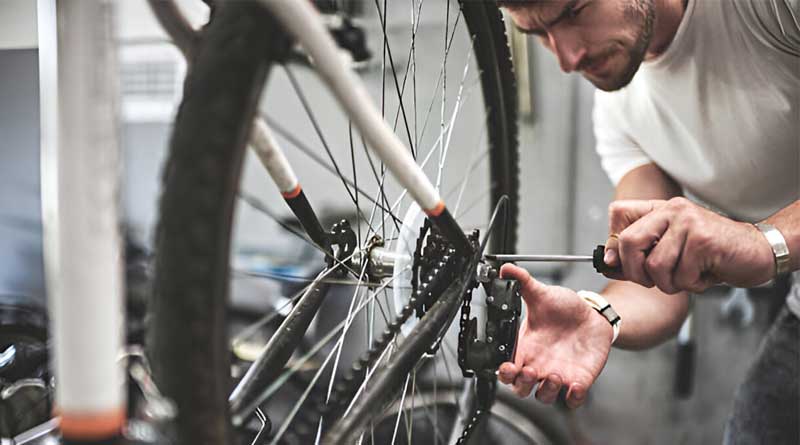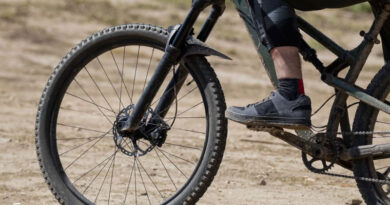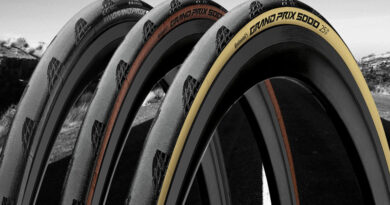Best Budget Mountain Bike Tires of 2025
Finding the right mountain bike tires can be hard, especially on a tight budget. Good tires improve your ride and safety. They help with grip, control, and comfort on rough trails. Many people think budget tires are low quality. But that is not always true. Some affordable tires offer great performance and last long too. You just need to know where to look. This article will help you choose the best budget mountain bike tires. We will cover different types, features, and prices. You will also learn tips for picking the right tire. Let’s make your biking fun, safe, and affordable!
1. WTB Urban Bike Tire
-
Tire Size: 700c x 32mm – 47mm range
-
Tread Pattern: Smooth centerline with micro-knob shoulders
-
Casing: Durable wire bead construction
-
PSI Range: 35-65 PSI
The WTB Urban Bike Tire is an excellent choice for city riders who demand both performance and style on paved roads. Designed with a smooth centerline tread pattern, this tire ensures reduced rolling resistance, allowing for a smooth and swift urban commute. The micro-knob shoulders provide just enough grip to handle sharp corners and wet conditions, making this tire versatile for both dry and light rainy days. Its robust casing construction offers protection against minor road hazards, so you won’t have to worry too much about glass shards or small debris.
This tire stands out for its durability and ability to handle a wide pressure range, making it adaptable for different riding experiences — whether you’re out for a relaxed cruise or commuting at higher speeds. The WTB Urban Bike Tire also balances comfort well, thanks to its moderate width options, cushioning urban imperfections like potholes and cobblestones. For anyone seeking a reliable and stylish upgrade for their city bike, this tire offers long-lasting performance with minimal maintenance concerns.
Pros:
-
Smooth rolling performance for urban roads
-
Excellent grip on corners thanks to micro-knob shoulders
-
Wide PSI range for personalized comfort and speed
-
Durable construction reduces frequent replacements
Cons:
-
Limited to urban use; not suitable for trails
-
Slightly heavier than some competitor tires
2. Continental Mountain Bike Tire
-
Tire Size: 26” x 2.2” (varies by model)
-
Tread Pattern: Aggressive, multi-directional knobs
-
Compound: PureGrip or BlackChili Compound options
-
Sidewall Protection: ShieldWall or ProTection casing
Continental’s Mountain Bike Tire is built for those who take their off-road adventures seriously. This tire combines German engineering with advanced rubber compounds to deliver reliable grip and endurance, especially in rugged environments. The aggressive tread pattern ensures optimal traction on dirt trails, loose gravel, and muddy conditions. Whether you’re climbing a root-laced hill or descending through rocky terrain, the multi-directional knobs bite into the surface with confidence, providing the rider with great control and stability.
What really sets Continental apart is their proprietary rubber compounds like PureGrip or the more premium BlackChili Compound, which enhances both grip and longevity. The sidewalls, reinforced with ShieldWall or ProTection technology depending on the variant, are designed to withstand punctures and abrasions without adding excess weight. Overall, this tire is an excellent companion for adventurous mountain bikers looking for all-around performance and durability.
Pros:
-
Exceptional grip on diverse terrains
-
Strong sidewall protection against punctures
-
Available in multiple compounds for tailored performance
-
Long-lasting tread life even on rough trails
Cons:
-
Slightly pricey compared to entry-level mountain bike tires
-
Increased rolling resistance on paved roads
3. Hycline Bike Tire
-
Tire Size: 26″ x 1.95″ or 2.125″
-
Tread Pattern: Dense center tread with rugged outer knobs
-
Casing: High-density puncture-resistant layer
-
PSI Range: 40-65 PSI
The Hycline Bike Tire is designed for versatile use across both paved streets and light off-road conditions, making it an excellent option for recreational riders and commuters who like to switch between environments. The dense center tread ensures a smoother rolling experience on pavement, while the rugged outer knobs offer stability and grip on dirt paths, grassy surfaces, and uneven trails. Its puncture-resistant layer adds peace of mind for those who regularly ride over mixed surfaces littered with sharp objects or debris.
Beyond durability, the Hycline Bike Tire provides a smooth and balanced ride, handling well at both lower and higher tire pressures. The wide PSI range allows you to adjust the tire feel according to terrain — a lower PSI for better grip on soft surfaces and higher PSI for efficient rolling on asphalt. It’s a budget-friendly choice that doesn’t compromise too much on performance or safety, making it ideal for casual cyclists or weekend riders.
Pros:
-
Affordable price without skimping on quality
-
Versatile tread design for urban and light off-road use
-
Puncture-resistant construction for enhanced durability
-
Smooth performance on both paved and mixed surfaces
Cons:
-
Not suitable for advanced off-road trails
-
Can feel stiff at maximum PSI on rough surfaces
4. WTB Mountain Bike Tire
-
Tire Size: 27.5” x 2.25” or 29” x 2.25”
-
Tread Pattern: Aggressive, open-spaced knobs for mud shedding
-
Compound: Dual DNA Rubber Compound
-
Sidewall Protection: Lightweight but reinforced with puncture guard
WTB’s Mountain Bike Tire is a rugged and dependable choice for riders who frequent off-road trails, rocky paths, and unpredictable terrain. Engineered with a thoughtful balance of grip and rolling efficiency, the open-spaced, aggressive tread sheds mud and debris effectively, preventing traction loss even on wet and loose surfaces. Whether you’re cornering on dirt switchbacks or climbing over root-laden paths, this tire offers a strong sense of control and stability.
Another standout feature is WTB’s Dual DNA Rubber Compound, which provides softer rubber on the outer knobs for grip and a firmer centerline for speed and durability. The sidewalls are fortified to handle sharp rocks and sticks while still maintaining a reasonable weight for a mountain tire. WTB’s reputation for producing reliable, performance-focused tires shines through with this model, making it perfect for weekend warriors and serious trail enthusiasts alike.
Pros:
-
Excellent mud-shedding capabilities due to open tread design
-
Balanced rubber compound for both grip and speed
-
Strong sidewall protection reduces puncture risks
-
Good performance across a variety of trail conditions
Cons:
-
Can be noisy and sluggish on paved roads
-
Slightly more expensive than entry-level MTB tires
5. Chao YANG Mountain Bike Tire
-
Tire Size: 26” x 1.95” or 27.5” x 2.1”
-
Tread Pattern: Dual tread with center ridge and pronounced shoulder knobs
-
Compound: Durable all-terrain rubber blend
-
PSI Range: 40-65 PSI
The Chao YANG Mountain Bike Tire is an affordable yet surprisingly capable option for budget-conscious mountain bikers. Designed with a dual tread profile, this tire offers both a fast-rolling center and pronounced shoulder knobs, giving you solid control and cornering grip on both dry and moderately wet surfaces. The tire balances speed and traction quite well, making it suitable for casual trail rides and daily commutes through urban shortcuts.
Despite its budget-friendly price tag, Chao YANG has packed the tire with durable rubber compounds that resist premature wear and deliver reliable puncture resistance. The tread design helps to maintain grip even when the surface changes unexpectedly, which is ideal for beginners looking for confidence and stability in their rides. If you’re looking for an entry-level mountain bike tire that doesn’t cut corners on quality, this model is a solid pick.
Pros:
-
Affordable pricing for a durable mountain tire
-
Balanced design for both speed and control
-
Effective cornering grip with reinforced shoulder knobs
-
Suitable for both urban and trail riding
Cons:
-
Not ideal for extremely technical or rocky trails
-
Slightly less effective in heavy mud conditions
6. RimRunner Bike Tire
-
Tire Size: 26″ x 1.95″
-
Tread Pattern: Semi-aggressive all-terrain design
-
Sidewall: Reinforced casing for added stability
-
PSI Range: 40-65 PSI
The RimRunner Bike Tire is a classic all-terrain option designed to meet the needs of versatile riders who split their time between paved roads and trails. The semi-aggressive tread pattern allows for reduced rolling resistance on smooth surfaces while still providing enough grip when the terrain shifts to gravel, dirt, or grass. It’s a go-to tire for people who use their bike for both daily commuting and weekend adventures.
What makes this tire particularly appealing is its reliable construction at an accessible price point. The reinforced sidewalls offer stability on sharp turns and resistance against punctures from rough patches or stray debris. If you’re not a hardcore mountain biker but still want a tire that can handle more than just asphalt, the RimRunner gives you a dependable, no-fuss solution that bridges the gap between road and trail riding.
Pros:
-
Balanced design for both road and light trail use
-
Durable sidewall construction for extra protection
-
Smooth ride on paved surfaces
-
Good value for the price
Cons:
-
Limited grip on technical off-road trails
-
Basic rubber compound compared to high-end tires
7. YUNSCM Mountain Bike Tires
-
Tire Size: 26” x 1.95”
-
Tread Pattern: Raised center ridge with spaced outer knobs
-
Material: High-quality rubber with anti-puncture layer
-
PSI Range: 40-65 PSI
YUNSCM Mountain Bike Tires are designed with practicality and durability in mind, making them a great replacement tire for budget-minded riders. The raised center ridge reduces friction on paved roads for a faster, smoother ride, while the spaced outer knobs enhance grip and stability on dirt and gravel trails. The anti-puncture layer underneath the tread offers extra security against sharp objects, extending the life of the tire.
These tires strike a nice balance between performance and price, especially for casual riders who want a reliable all-rounder. They’re easy to install and fit most standard mountain bike rims, making them a convenient option for DIY bike maintenance. If you’re the type of rider who values steady, predictable performance for commutes and weekend trail rides, YUNSCM’s tires are a smart and economical choice.
Pros:
-
Affordable and reliable for casual riders
-
Anti-puncture layer adds extra safety
-
Good balance of speed and traction
-
Easy installation and compatibility with standard mountain bikes
Cons:
-
Not ideal for aggressive or technical trail use
-
Average cornering performance on loose surfaces
How to Choose the Best Budget Mountain Bike Tires
Mountain biking is a fun and thrilling sport. But it can get expensive very quickly. One of the most important parts of your bike is the tire. Tires affect your comfort, speed, and safety. If you are on a budget, choosing the right tire is not always easy. There are many options and many things to consider. But if you know what to look for, you can save money and ride safely. This guide will help you choose the best budget mountain bike tires.
Understanding Your Riding Style
Before buying any tire, it is important to understand your riding style. Different trails and surfaces need different types of tires. If you mostly ride on smooth paths, you will need a lighter tire. If you ride on rocky or muddy trails, you will need a tire with strong grip. Knowing your usual riding conditions is the first step in choosing the right tire. A tire that suits one trail may not work well on another. So always consider where you ride most of the time.
Knowing the Right Tire Size
The size of the tire is very important for a mountain bike. Tires come in different sizes such as 26 inches, 27.5 inches, and 29 inches. The right size depends on your bike frame and personal comfort. Bigger tires usually offer more grip and a smoother ride. Smaller tires are often lighter and easier to control. If you are unsure, you can check your bike manual. The manual will tell you the right tire size for your bike model. Always buy the correct size to avoid safety risks.
Understanding Tread Patterns
The tread pattern is the design on the tire’s surface. This pattern affects how your bike grips the road or trail. Deep treads offer more grip on muddy or loose surfaces. Shallow treads roll faster on dry and flat roads. Some tires offer a mixed tread design. These work well on both wet and dry trails. If you often change trails, choose a balanced tread pattern. This way, you won’t need different tires for every trip. Tread is one of the most important things to check when buying a tire.
The Importance of Tire Width
Tire width plays a big role in comfort and performance. Wider tires provide more grip and better balance on rough paths. They also absorb shocks better, making the ride smooth. Narrow tires are lighter and faster on hard-packed trails. They are good for riders who like speed over grip. Your choice depends on your style and the surfaces you ride on. Beginners usually feel more comfortable with wider tires. They offer extra stability on uneven ground.
Choosing the Right Tire Compound
Tire compound means the rubber material used to make the tire. Soft rubber gives more grip but wears out faster. Hard rubber lasts longer but has less grip on wet trails. Many budget tires use hard compounds because they are more durable. But some affordable options offer a good mix of grip and long life. If you ride on rocky or wet paths, soft rubber might be worth the extra cost. But for dry trails, a hard compound can save you money in the long run.
Checking for Puncture Protection
Mountain biking often leads you over sharp rocks, thorns, and debris. Cheap tires often have no puncture protection. But some budget-friendly options include extra layers under the tread. These layers help reduce the risk of flats. A flat tire can ruin your ride and cost more in repairs. So even on a budget, try to choose a tire with at least some puncture protection. It will save you both time and money later on.
Understanding Tubeless vs Tube Tires
Another choice you will face is between tubeless and tube tires. Tubeless tires are more modern and reduce the risk of flats. They can also be run at lower air pressure for extra grip. But they cost more upfront and need special rims. Tube tires are cheaper and easier to install. If you are on a tight budget, tube tires are usually the better choice. But if you can stretch your budget a little, tubeless tires are a great investment.
Sidewall Strength and Durability
The sidewall is the side part of your tire. It plays an important role in protecting the tire from damage. Thin sidewalls are lighter but can tear on sharp rocks. Thick sidewalls offer more strength but can make the tire heavy. Some budget tires now offer reinforced sidewalls. These are perfect for rocky or rough trails. If you ride on smooth paths, sidewall strength is less important. But for off-road trails, always check the sidewall quality.
Reading Customer Reviews
Before buying any tire, always read customer reviews online. Other bikers often share helpful tips and honest feedback. Reviews will tell you about real-life performance, comfort, and durability. A tire might look great in photos but fail on tough trails. Learning from other riders’ experiences can save you money and trouble. Online reviews can also alert you to common problems with a specific tire model.
Balancing Price and Quality
When shopping for budget mountain bike tires, it is easy to focus only on price. But the cheapest option is not always the best. A poor-quality tire may wear out faster or fail when you need it most. Instead of looking for the lowest price, search for the best value. Sometimes spending a little more can give you a tire that lasts longer and performs better. This way you save money over time by avoiding frequent replacements.
Trusted Brands Offer Better Budget Options
Well-known tire brands often offer reliable budget models. These models give you good performance at a lower price. Brands like Maxxis, Schwalbe, and Continental have affordable choices. Trusted brands usually test their products more carefully. Their budget models often have better safety and durability. Unknown or very cheap brands may look tempting but might not last long. If you are unsure, start with an entry-level tire from a known brand.
Maintenance Increases Tire Life
Once you have bought the right tire, maintenance is important. Keeping your tire clean and properly inflated will increase its life. Check your tire for small cuts or worn-out treads after each ride. Replace the tire if you see damage or deep cracks. Good maintenance means you won’t need to buy new tires too often. It also keeps your ride safe and smooth. Even the best tire will not last if you don’t take care of it.
Final Thoughts
Choosing the best budget mountain bike tire takes a little time and research. But it is worth the effort. The right tire will make your rides safer, smoother, and more fun. Start by understanding your riding style and your bike’s needs. Focus on size, tread, width, and compound. Check for puncture protection and sidewall strength. Read reviews and choose from trusted brands whenever possible. A little extra care during your purchase can save you from big headaches later. With the right tire, even budget biking can feel like a premium experience.




